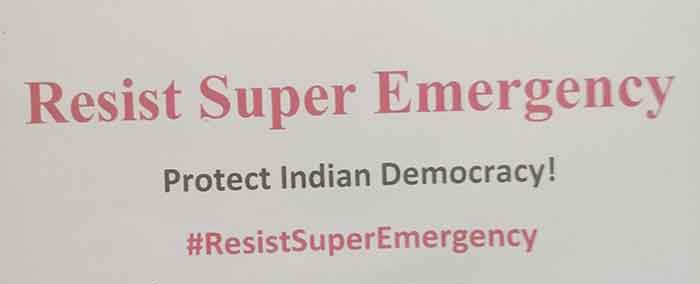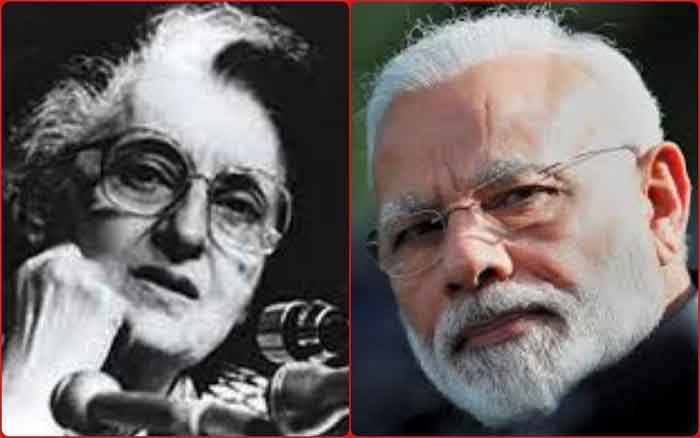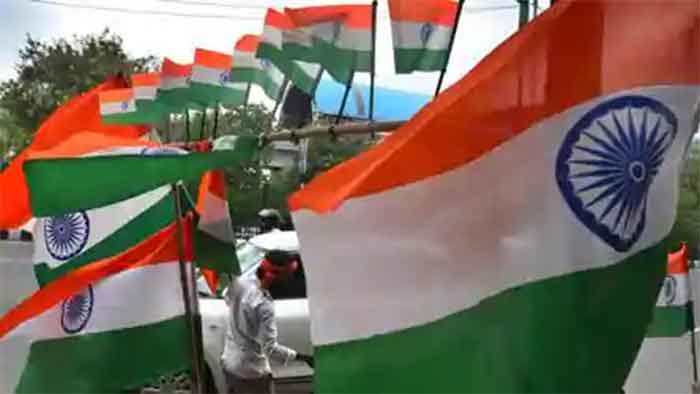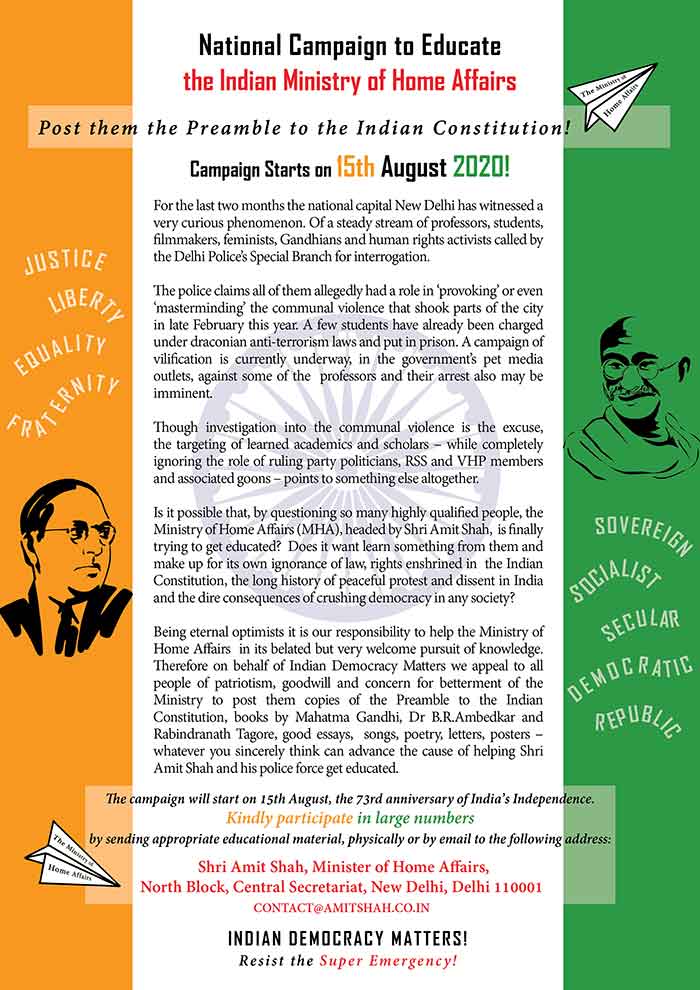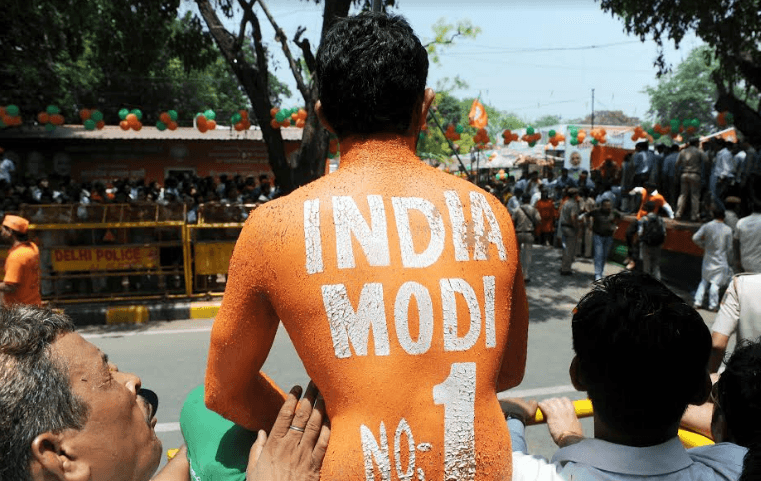(This is part-1 of a two-part article on Emergency, formal and Undeclared.)

“People lost even right to life during Emergency” said Prime Minister Modi, in the 90th episode of Mann Ki Baat, June 26. He reminded the nation about the imposition of Emergency 47 years ago, recalling how the “right to life and liberty” was snatched from citizens and an attempt was made to crush democracy. (timesofindia.com, June 27, 2022).
It was good that the PM with all his oratorial skills spoke on a key subject ‘forgotten’ by most of the media in recent years.
Modi said, “I want to ask a question to the youth of today’s generation, to the youth in the age group of 24-25 years, and the question is very serious… do ponder my question over. Did you know that when your parents were your age, once even their right to life was snatched away from them? You must be thinking how could this have happened? This is just impossible! But this had happened once in our country,” the PM said as he started the Mann Ki Baat talk with reference to Emergency and the mass movement that followed which he said was of great importance in the life of every citizen of the country.
The PM said, “This took place years ago in 1975. It was the month of June when Emergency was imposed. All the rights were taken away from the citizens of the country. One of those rights was the ‘Right to Life and Personal Liberty’ provided to all Indians under Article 21 of the Constitution. An attempt was made to crush democracy. The country’s courts, every constitutional institution and the press were put under control. The censorship was such that nothing could be printed without approval.”
Modi said when famous singer Kishore Kumar refused to applaud the government, he was banned and he was not allowed on radio. “But even after thousands of arrests and atrocities on lakhs of people, the faith of the people of India in democracy was not shaken… not at all!”
The PM said the people of India eventually reestablished democracy in a democratic way. “It is difficult to find such an example of defeating a dictatorial mindset, a dictatorial tendency in a democratic way, in the whole world,” he said.
Recalling his own experience of those days, Modi who was also imprisoned said: “Today, when the country is celebrating 75 years of its independence, celebrating Amrit Mahotsav, we should never forget that dreadful period of Emergency. The generations to come should also not forget. The Amrit Mahotsav not only encompasses the victory saga of freedom from hundreds of years of slavery, but also the journey of 75 years after independence. We move forward, learning from every important stage of history.”
The PM needs to be thanked for reminding the youth of today’s young generation, the way Rule of Law was implemented in India decades ago. And thanked for reminding of the mass movement that followed which he said was of great importance in the life of every citizen of the country.
He was referring to the fact that “right to life and liberty” was snatched away, suspended by law during Emergency ( announced midnight on June 25, 1975, and lifted on March 21, 1977 ) imposed by PM Indira Gandhi’s autocratic regime.
It should be stressed and recalled that the Supreme Court had upheld the Emergency, and various Black laws, and there emerged a judiciary that was ‘committed’ to Indira’s ways.
Modi repeated the point in Germany the same day while addressing thousands of members of the Indian community at a grand event held in Munich, which he visited to attend the G7 Summit. He called it a “black spot” on the vibrant history of India’s democracy, and targeted the Congress Party.
He said that “democracy, which is in DNA of every Indian, was trampled and suppressed 47 years ago…The people of India answered all the conspiracies to crush democracy in a democratic way. We Indians take pride in our democracy wherever we are,” Modi said in his over 30 minutes speech at the crowded stadium, full of Indian community who had come to Munich after travelling long distances. It was a ‘well-organized’ show, known to NRIs in USA.
Modi had targeted the Congress party for imposing the Emergency, and asserted that it is difficult to find another example in the world where people defeated a “dictatorial mindset” through democratic means.
Those in the Establishment often object to such internal matters, negative things, being said on a foreign land. But the king can do no wrong.
That’s what the Supreme Court apparently conveyed latest when it gave a clean chit to the PM in a case related to Gujarat massacre. Of course it did not deny the massacre, or the omissions and commissions of the Modi regime; it only said there was no prior conspiracy for that.
Promptly acted the state: Teesta Setalvad, the woman advocate who fought the State in courts for decades was summarily imprisoned following some observations by the top court: a brazen warning to advocates what kind of cases they dare not take up.
“Today, India believes in itself and its capabilities. That’s why we’re breaking old records and achieving new goals,” he said.
Yes, breaking old records of Emergency by ways of Undeclared Emergency…
Teesta’s fate is a testimony: Yes, Modi said India has shown how well democracy is delivering in such a vast and so diverse country, in ever new ways, without formal Emergency:
…scores of lynchings, bulldozing homes, refusing bail for years – rejecting protests and pleas by scores of Nobel laureates form across the world – to laymen as well as intellectuals aged 80-plus and wheel-chair-bound paraplegics, denying or delaying medicines, refusing even a sipper to the sick and old Stan Swamy who could not hold his tumbler – this (sipper) had to raised in top courts.
Modi spoke of technological revolution:
“In Information technology, digital technology, India is making its presence felt. Forty per cent digital transactions in the world are from India. India is making new records in data consumption. India is among the countries where data is cheapest.” … In India’s many places, fertilisers are being sprayed using drones, he said.
“In last century, Germany and other countries benefited from the 3rd Industrial Revolution. India was a slave back then that’s why it couldn’t leverage benefits. But now India will not be left behind in the 4th Industrial Revolution, it’s now leading the world,” Modi said.
Yes, the best example is: using Pegasus technology to spy on all its critics and opponents, compromising their laptops and mobile phones by use of ever new spy soft-wares…
“This list of achievements is very long. If I keep speaking, your dinner time will be over. When a country takes correct decisions with correct intentions on time, then it is destined for development,” he said, amid chants of Modi-Modi from the crowd, the media reports added.
Yes, he had no time to tell of so many other achievements:
No formal censorship, but…
The PM spoke of formal censorship during Emergency. His senior LK Advani, former minister, had famously said how journalists, when asked to bend,had crawled before authority. Modi and Home Minister Amit shaw know better how they are handling the media today.
Without any formal censorship, the new ways of arm-twisting now are:
Silencing critics and the media by carrot and stick, bullying or buying over editors and RTI activists, using UAPA and colonial sedition laws against thousands of activists, launching IT ED CBI raids against political opponents…the list is endless.
Latest RSF 2022 World Press Freedom Index showed India’s place: it’s now ranked150, out of 180, down from 142 last year. The report stated: “..a broader crackdown on dissent has emboldened the Hindu nationalists to threaten,harass and abuse journalists critical of the Govt, both online and offline with impunity.”
Three journalists’ bodies of India endorsed the Report, notwithstanding questions about biases of the Western ‘liberal’ agency. That’s an Index of democracy from the West Modi has been allied with.
Brazen half-truths
“The way crores of Indians have achieved big goals together, it is unprecedented. Today every village in India is open defecation free (ODF), has electricity and 99% of the villages also have clean cooking fuel…” he added. “Today cleanliness is becoming a lifestyle in India.”
Germans in Munich must have thought of how Goebbels had a worthy successor: The PM was brazen to tell half-truths:
Anyone traveling in India by train or bus early morning time can see along the way, people defecating in the open, and kitchen-smoke coming out of homes. We see cities and towns stinking and struggling to handle garbage dumps, and sewerage systems.
There are more latrines built, no doubt, but ODF claims are exposed to be false: ODF is “ not eliminated in any of the districts surveyed in North India” a report said based on a survey. Data are fudged. Even official sources don’t endorse the PM’s claims: National Family health Survey-5, March 2022, says 83 % households have access to toilets, but 19% do not use any facility.
Yet, we must believe: “Today cleanliness is becoming a lifestyle in India.”
But negative thoughts should be discouraged when we speak of development!
“Today the people of India are confident that their money is used honestly for the country, corruption is not getting paid. That’s why tax compliance is increasing rapidly in the country,” Modi said.
Vijay Mallyas, Nirav Modis and Choksis must be celebrating his speech! So must be those involved in massive NPAs and banking scams that the PM gives a clean chit!
BJP top brass tell us how so many non-BJP ruled states are steeped in corruption: are they not part of India Modi is speaking of? Leave them: We saw how in Karnataka, BJP’s veteran former CM Yeddyurappa had to be dumped for being caught in huge corruption, and was brought back into the party leadership again; and there again a BJP Deputy Chief Minister, KS Eashwarappa, very recently, had to be dropped from the cabinet when he was found to be pressing for 40% commission as bribes, as alleged by his own party man-cum-contractor Santosh Patil who committed suicide.
Modi, now being projected by his party and its media, as Viswa Guru and neta (world’s teacher and leader) said that Indians are proud of their democracy.
“Today, we can proudly say that India is the mother of democracy… The diversity of culture, food, clothes, music and traditions makes our democracy vibrant.”
Today? Tomorrow? Do the PM and his party really want such an India?
People all around see diversity of clothes and head-dresses the PM wears during his tours, but alas the whole world also sees how in Bengaluru, India’s Silicon valley, not to speak of remote areas- all these are diversities are sought to be denied – even top courts are aiding in the process, and discriminating between the Hindu ghunghat and the Muslim hijab, the head scarf girl students wore for decades while going to schools.
And people have seen how beef (even other meat that is ‘suspected’ to be so) has become a dangerous thing that may invite daylight lynchings!
Hundreds of disgraceful ‘honor killings’ are reported from across India. As if they are not enough, laws are being enacted across states to prohibit inter-faith marriages in the name of Love Jihad.
Now we shall see in the next section how his best colleague from UP, the largest state with a population of 230 miilions – almost equal to three Germanys the PM was visiting and speaking there – is making a mockery of Rule Of Law And indulges in Law-Less Rule Of Undeclared Emergency, the new normal, with lynchings, encounters and bulldozers.
“India has shown that democracy can deliver and has delivered,” said the PM, the Viswa Guru. They show the way: Rule Of Undeclared Emergency, the new normal in India.
*** ***
Undeclared Emergency, the new normal, with sedition and UAPA cases, lynchings, custodial torture and deaths, encounters and bulldozers
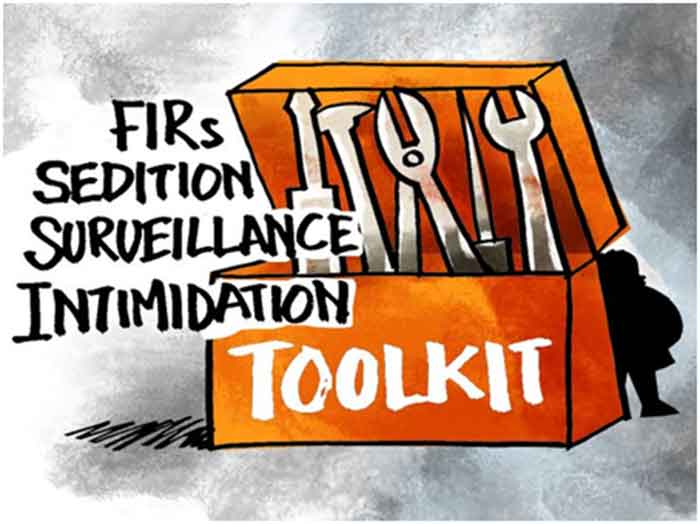
(Courtesy: Dominic Xavier for Rediff.com, for both cartoons)
Sedition and UAPA cases, for silly reasons, are by now notorious, the top Courts took note of, though with little action. It takes years even to get bail under the relevant provisions, flouting the Court-prescribed maxim that ‘bail is the rule, and jail an exception.’ The Indian State found in them the best way to negate the right to liberty, without the need for Emergency.
This trend of Undeclared Emergency had commenced much before NDA regime arrived, in the face of intensive movements for civil and democratic rights (which led to ignominious defeat of Indira-led Congress in 1977), and court verdicts that restricted the state’s powers of Constitutional autocracy. The consequent 44th Constitutional Amendment of 1978, and Amendments to Article 352 (wherein for instance, internal disturbance as a cause (or better, alibi) for Emergency that was replaced by the more explicit armed rebellion) and to Article 356 by Bommai judgment.
Repression, even autocracy, has two forms, Constitutional and lawful, and unconstitutional and lawless, and a combination of the two.
Custodial violence and deaths is an age-old method. If post-Indira Congress innovated several ways of Undeclared Emergency and lawless repression, the BJP perfected them: Several Black Acts like TADA, POTA, Disturbed Areas Act, UAPA and AFSPA Amendments, Sedition provisions, Prevention of Damage to Public Property Act, are some among them. Then endless ways of illegal repression and fascist methods are resorted to, like illegal detentions, endless detentions without trial, denial of bail as a rule, custodial deaths, extra-judicial killings like fake encounters and ‘disappearances’ of tens of thousands people.
The BJP proved to be more innovative from Godhra days till Adithyanath regime, as we shall see later in this article. Recently, the Police in BJP-ruled Tripura charged lawyers and social media handles under the anti-terrorism law, Unlawful Activities (Prevention) Act, 1967 (UAPA). The social media were booked for making posts, which according to the police, had the ‘potential to flare up communal tension’ in the state.
‘Committed’ judiciary then, more pliable judiciary now
Judges’ appointments have been a matter of clash between the judiciary and the government : Top judges argued, shed tears in public. Each side spoke of Lakshman rekha, and there is still fiction. Meanwhile things are changing:
A pliable and more co-operative judiciary (like Indira Gandhi’s committed judiciary), aided by selective, caste-based and political appointments; post-retirement political and judicial rewards; Bench-hunting and manipulating Benches; corruption even in higher echelons of judiciary; threats of contempt of court; intelligent use of ‘not before me’ and immunity provisions are all invoked to aid the State in repressive ways.
The ‘Hindutva judgment’ of 1996 April, the more recent Ayodhya and Godhra verdicts, Koregaon and Elgar Parishad cases, denial of bails etc, are noteworthy landmarks. Judicial punishments of Justice Markandeya Katju and lawyer Prasahant Bhushan are warning shots from the judiciary.
*** ***
“Murders passed off as Deaths” : 1727 persons died in custodial violence
“Murders passed off as Deaths” is the title of a comment (5 Oct 2021) by eminent jurist Dr. Madabhushi Sridhar, former Commissioner of RTI. He wrote:
“ We call Gandhi as Father of our nation, who preached non-violence, but police stations remain mothers of custodial violence throughout the country.
Chief Justice of India N V Ramana on Gandhi Jayanthi said police stations pose the “highest threat” to human rights and dignity. We call these human rights and dignity as ‘sacrosanct’. The CJI explained: “The threat to human rights and bodily integrity is the highest in police stations… Going by recent reports, even the privileged are not spared third-degree treatment”.
Extracts from his article are illuminating and self-explanatory:
“ In fact, very nomenclature is pro-police. They describe them as lock-up deaths, which are in fact murders in lock up. Another camouflaged expression is custodial violence, which in fact is committing crime of causing grievous injury as per Indian Penal Code.”
Not all cases of custodial violence and lock-up deaths are recorded and reported. killed becomes died.. Just they were Of those that are reported, he comments:
“ During 17 years till 2018, 1727 persons died in custodial violence in India. Just they were killed. According to data released by National Crime Records Bureau NCRB, only 26 policemen were convicted…”
“ Though it is clear that our laws are mostly confined to shelves and implementation is an exception, it is required to know the law that stands against the human rights violation.
“Human rights violations are rampant in police stations. There were around 2,000 cases recorded against the police between 2000 and 2018, but only 344 policemen were convicted in these cases.
“ Reasons are obvious and well known. There is no transparency in police functioning. After somebody is taken into custody, none knows what happened to the person in custody.
“All the rights prescribed, are pieces of academic research”
“All the rights prescribed, declared by the Judiciary and incorporated in the form of amendments into Criminal Procedure Code are pieces of academic research, and absolutely not available to poor…Those profound judicial niceties are points of arguments of highly rich lawyers who are available to highly rich criminals.
“The CJI noted that the lack of effective legal representation at police stations is a huge detriment to arrested or detained persons. He has rightly said that the first hours of arrest or detention often decide the fate of the case for the accused.
“The use of excessive force including torture to target marginalised communities and control people participating in movements or propagating ideologies which the state perceives as opposed to its stature are other reasons.
“The media mostly do not stand in favour of poor and lower class accused persons… who have no legal representative with them, because he cannot afford. It’s a luxury (available to) criminally charged politicians, bank fraudsters, corporate criminals, and scandal involved bureaucrats etc.
“Other reasons of course are the lengthy, unpredictable and expensive formal processes followed by courts, which dissuade the poor and the vulnerable from even complaining.
Secrecy around custody
“Even the entire prison system is inherently opaque giving almost no room to transparency. The prisons are kingdoms of powerful officers, where their writ will run.
“Human rights jurisprudence and judiciary prudent judges somewhere help the rights to survive now and then.
“ India has signed but not ratified the United Nations Convention Against Torture since 1997. Mere signing simply indicates the country’s intention to meet the obligations set out in the treaty, but the ratification, on the other hand, entails bringing in laws and mechanisms to fulfil the commitments.
“Human Rights Protection law is a paper tiger”
“ We are known for having profound intentions only, and when it comes to committing, we are far away. We claim India as welfare state, but every Prime Minister and the Chief Ministers desire to rule with iron hand of the police to suppress opposition, dissent and criticism.
We have Protection of Human Rights Act but the institutions are under the control of the executive, filled by the retired Chief Justices or senior justices, as a return gift for their coordination and cooperation with the Government during their pre-retirement tenure. Unfortunate.
“State Human Rights Commissions are also reduced to be non-serious institutions as they are headed by retired persons. The institution of human rights court in district and further lower level remained on paper.
“ Unless these Commissions at National and States and district or taluk Human Rights Courts are made regular courts with youngsters institutionalising into a cadre and removed the scope of flourishing as rehabilitation centre of retired judges, corruption in judiciary and non-serious functioning of human rights forum will continue, while people suffer torture in police stations..
“ While this Human Rights Protection law is weak and a paper tiger, there is no other anti-torture legislation to penalise culpable uniform criminals and criminalize custodial violence.
“The vulnerable lived outside the system of justice”: C J I
Madabhushi continues: We need to read again what CJI has said:
“If the judiciary wants to gain the trust of the poor and vulnerable, it has to assure the marginalised that it exists for them. For the longest time the vulnerable sections have lived outside the system of justice. ..Lengthy, expensive formal processes followed by courts dissuade the poor and the vulnerable. The judiciary’s toughest challenge today is to break these barriers”.
And finally, it is relevant to recall CJI’s another statement:
“If we want to remain as a society governed by the rule of law, it is imperative for us to bridge the gap of accessibility to justice between the highly privileged and the most vulnerable. For all times to come, we must remember that the realities of socio-economic diversity which prevail in our nation cannot ever be a reason for denial of rights. Let our past not determine our future…”
(see more on the subject in Counter Currents.org, July 5, 2021)
*** ***
‘Offences against State’ : 49,000 odd cases registered under Modi regime
The following are some other forms of undeclared emergency. We cite in this section extensively from a well-researched paper published by factly.in, specializing in data analysis.
‘Offences against State’ is a category that includes cases booked under sedition, Unlawful Activities Prevention Act (UAPA), Official Secrets Act, damage to public property, and imputation, assertions prejudicial to national integration. The NCRB report began publishing comprehensive information on ‘Offences Against the State’ only since 2014.
During the seven-year period (2014 to 2020), the cases registered under UAPA and Sedition together constituted nearly 15% of all the cases registered under this head. Of the total 49,000 odd cases registered during this period, a total of 6,900 cases were registered under UAPA and 399 cases were registered under Sedition.
According to the NCRB Crime in India (CII) report, a total of 5,613 cases of ‘offences against the State’ were registered by police across the country in 2020 alone; the lowest since 2015. This includes 796 cases under UAPA and 73 cases under Sedition. However, this number is the least since 2015. The number of registered cases of ‘offences against the state’ increased from over 5,000 in 2014 to more than 9,000 cases in 2017- an increase of nearly 67% in three years.
*** ***
6,900 cases registered under UAPA in 7 years of Modi rule
An average of 986 cases were registered under UAPA and 57 under Sedition, annually since 2014. While the number of cases under UAPA went up from 897 in 2015 to more than 1200 in 2019, the number dropped to below 800 in 2020. This reduction is in line with the overall reduction in the number of crimes reported in the country. Meanwhile, the number of cases registered under Sedition crossed 50 in 2017 and touched the highest of 93 cases in 2019 and subsequently dropped to 73 in 2020. The reduction is because it was the year of the pandemic, when all activities were curbed.
The sedition legislation was brought in during the colonial rule to stop activities of Indians who would otherwise criticize or raise their voice against British rule, but it continues till today, the year of Amrit Mahotsav, in the neo-colonial India.
In 2018, the Law Commission of India released a consultation paper on sedition, that suggested a review. Further, in the 1962 case of Kedar Nath Singh vs. State of Bihar, the Supreme Court held that the law was to punish subversion of a lawfully established government through violent means only. But it is liberally used against writers and media persons wielding pens and cameras.
Of the total 6,900 cases registered during 2014 & 2020 under the UAPA, Manipur accounted for the highest number of cases with 2,595 accounting for almost 38% of such cases. Jammu & Kashmir is next in line with 1,208 cases followed by Assam with 1,071 cases: The three states reported more than 1,000 cases each, and accounted for nearly 71% of the cases registered in the country.
Jharkhand, Uttar Pradesh, Tamil Nadu, Bihar, and Kerala were the other states which reported more than 100 cases each. These five states along with Assam, Jammu & Kashmir, and Manipur, accounted for more than 95% of the cases registered in India. Numbers clearly indicate that more such cases are registered in the Northeastern states.
*** ***
400 Sedition cases registered between 2014 and 2020
Under the sedition law, Assam reported the greatest number of cases (66), followed by Jharkhand (40), Karnataka (38), and Haryana (37) during the seven-year period of 2014 to 2020. These four states, along with Jammu & Kashmir, Bihar, Kerala, Uttar Pradesh, and Manipur, 9 in all, accounted for 76% of the 399 cases registered under Sedition in all of India between 2014 and 2020.
The state-wise trend indicates that in Assam, 65 of the 66 cases were registered after 2016. Similarly, 25 of the 27 cases in Jammu & Kashmir, and 20 out of 21 cases in Manipur were registered after 2017. Though Bihar is among the top 6 states with the most sedition cases, the 25 cases registered in the state were in 2014 and 2015 only. No cases under sedition have been registered since then.
That most of the cases are fake, and on flimsy grounds, but are kept pending like Damocles’ sword, is well known. They are more than enough to scare and silence any dissent, even before one thinks of speaking out. For more serious persons, they are enough to scare and paralyze judiciary so as to deny even bails, let alone acquittals.
Patriotism and national security are mouthed to silence and threaten any media coverage against autocratic and fascist ways.
*** ***
82% cases under sedition and 85% under UAPA were pending disposal by police by end of 2020
Most of the cases are flimsy, and lame. They are just kept pending…a Damocles sword.
The pendency of all IPC crimes with the police was about 38.2% by the end of 2020 and 29.2% by the end of 2019. On the other hand, the percentage of cases registered under ‘offences against the state’ pending police disposal was the highest by the end of 2020 at 60.8% while it was 54.3% by the end of 2019. In other words, the police disposal of cases registered under ‘offences against the state’ was much lower compared to the other IPC crimes.
As far as sedition cases are concerned, 82.2% of the cases were pending with the police by the end of 2020 which was 69.4% by the end of 2019. For cases registered under UAPA, the pendency at the police was close to 90% by the end of 2016 which reduced to 76.5% in 2018 and increased to 85% by the end of 2020.
Pendency of Sedition & UAPA cases with the Courts crossed 90% by the end of 2020
The pendency of cases with the courts, registered under sedition was above 91% by the end of 2016 which reduced to 74.1% by the end of 2019. However, by the end of 2020, the pendency with courts increased to 94.5%. During the same period, the percentage of cases pending with the courts & registered under UAPA reduced from 97.8% by the end of 2016 to 88.4% by the end of 2019. However, as with other heads, the pendency of these cases with the courts increased to 94.6% by the end of 2020. In other words, only 5.5% of the cases under sedition and 5.4% cases under UAPA that were up for trial were disposed in 2020. This is in line with the court pendency all IPC crimes of 93.8%
(factly.in, NOVEMBER 11, 2021)
https://factly.in/data-three-states-accounted-for-more-than-70-of-uapa-cases-registered-since-2014/
*** ***
Prevention of Damage to Public Property Act
Notoriously as discussed above, 7,656 cases in 2019 and 5,613 cases in 2020 were launched in India, according to data released by the National Crime Records Bureau (NCRB), says a report of September, 2021. Of the 5,613 cases, 4,524 cases (80.6 per cent) were registered under the Prevention of Damage to Public Property Act, followed by 796 cases (14.2 per cent) under UAPA.
UP led by CM Adithyanath was notorious for using this Act, pulled up by the Supreme Court last February, 2022. It used them almost singularly against Muslim minorities who protested the notorious CAA. “UP played judge, jury and executioner.” It passed in 2020 a special Act for Recovery of damages.
Caught by the top Court, UP informed the Supreme Court that it has withdrawn 274 money recovery notices issued to protesters against CAA.
Neither BJP nor UP were exclusive in fascist ways.
Various states ruled by different parties vied with each other in launching fake cases under draconian laws:
Manipur, Jharkhand, Assam and Uttar Pradesh recorded the highest number of cases under UAPA — 169, 86, 76 and 72, respectively. Manipur, Assam, Karnataka and Uttar Pradesh recorded the highest number of sedition cases in 2020. While Manipur lodged 15 such cases, Assam registered 12, Karnataka 8, and Uttar Pradesh 7. Among the Union Territories, Delhi recorded 5 sedition cases.
Uttar Pradesh, saw a rise — 2,217 cases in 2020 compared to 2,107 such cases in 2019. Maharashtra registered the maximum number of cases (10) under the Official Secrets Act, followed by Rajasthan (6). Uttar Pradesh registered the highest number of cases (2,126) under Prevention of Damage to Public Property Act, followed by Tamil Nadu (639).
(theprint.in, 16 September, 2021)
*** ***
Fake Encounters in Tens of thousands
Encounters is a special word in India’s political lexicon, which means simply bumping off individuals by shooting them to death, a form of extra-judicial killing, and creating a fake story (hence called fake encounters) that police did so in self-defence.
Top courts took cognizance of the lawless crime, and asked the state to book each such case as one of murder and prosecute the police. But this is almost always violated, with impunity. One High Court judge had called, given such practices, Indian police as ‘criminals in uniform.’ Madabhushi used the word ‘uniform criminals’, as we saw above.
Not that (fake) encounter killings are new to India: Tens of thousands were killed that way in the 75 years of independence being celebrated as Amrit Mahotsav, not to speak of disappearances of thousands of civilians in Kashmir, all being matters before Supreme Court that censured them in some cases. In fact, they are upheld, and cinematized (Ab tak chappan, referring to 56 killings by a single police official.)
What is new is they are being justified by rulers of various parties, enabled by a pliable media that is re-moulding public opinion to justify them, on one pretext or the other.The top courts by their omissions and commissions, and verdicts delayed by years and decades are providing an alibi for the same.
Top IPS officer Sajjanar in Hyderabad was celebrated in a procession and hailed as a hero when four poor young men including minors were shot dead in an alleged (Disha) case of mass rape. Now a judicial commission ordered by the Supreme Court concluded it was a fake encounter, and prosecution of the police officials. Sajjanar however escaped being named; he is safely shifted out of the police department, to head TSRTC.
Notable is the fact that Yogi Adityanath, the undeterred Modi’s great team-mate, the UP chief minister had said that police will have full freedom to deal with rising crime rates in the state and asked criminals to either surrender or leave the state. The police promptly launched ‘Operation Clean’ and took no time in beginning to deal with the wanted men.
Double Engine Sarkar
Modi said India has shown how well democracy is delivering in such a vast and so diverse country, in ever new ways, without formal Emergency.
BJP leaders led by Modi are fond of speaking of Double Engine Sarkar; they show UP as a model how it is delivering goods. India is showing the way to the entire world, it is said: It includes ways of undeclared emergency.
Modi said: “We should never forget that dreadful period of Emergency. The generations to come should also not forget.”
Yes, now they should know, expose, and resist new forms of undeclared emergency.
*** ***
(In Part 2 , we shall see how UP has become a model for such ways, and a laboratory where their work is in progress).
Ramakrishnan was a political commentator, and contributed to counter currents.org.

